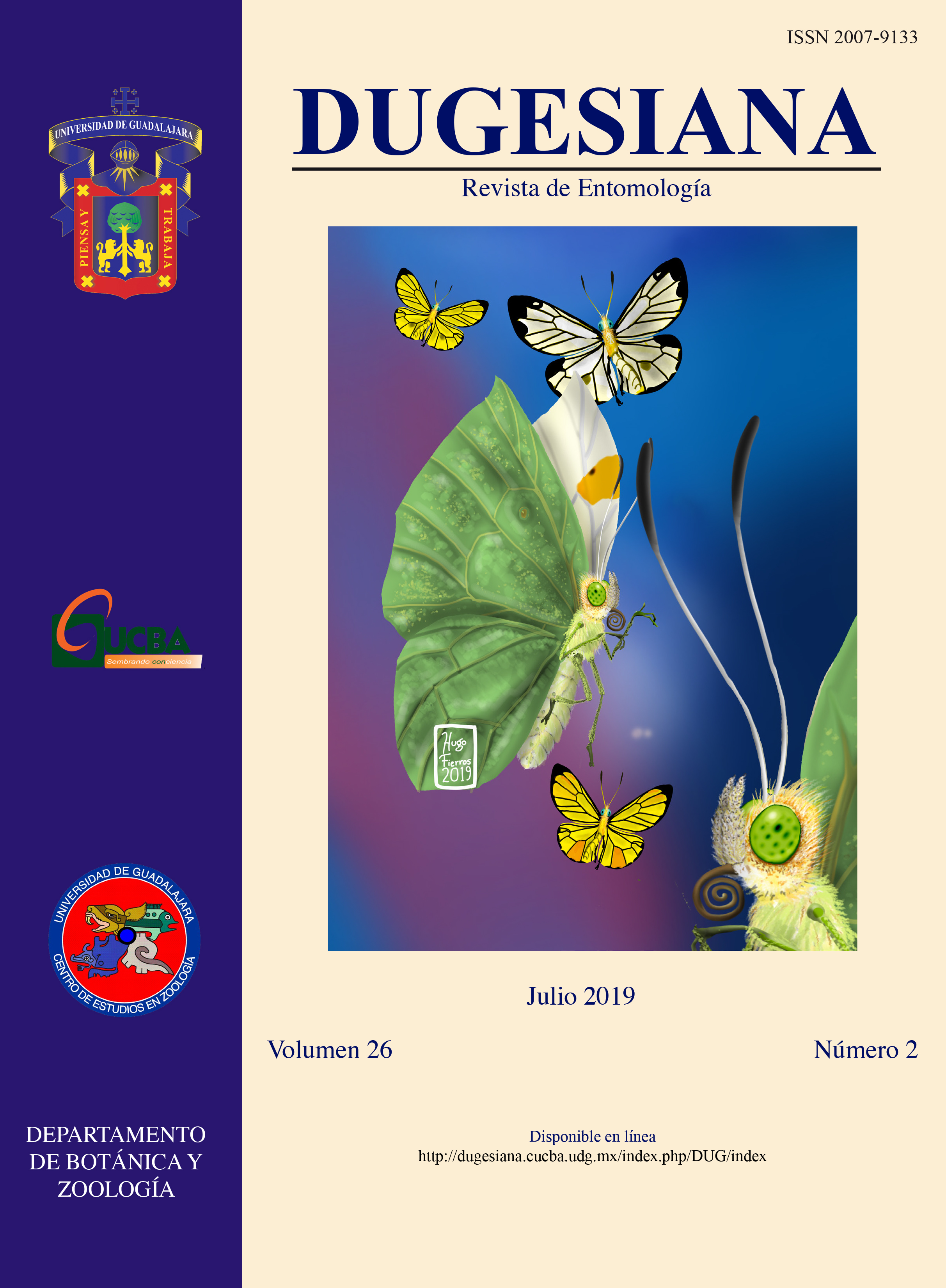Gregarious behavior of two species of Cassidinae (Coleoptera: Chrysomelidae) in Mexico
DOI:
https://doi.org/10.32870/dugesiana.v26i2.7069Keywords:
Gregariousness, Tortoise beetles, Physonota, Ogdoecosta, BromeliaceaeAbstract
Herein we report for the first time, the aggregation behavior of tortoise beetles Physonota humillis Boheman and Ogdoecosta epilachnoides (Champion), observed in inter-specific aggregation.References
Bengtsson, J. 2008. Aggregation in Non-social Insects: An Evolutionary Analysis. SLU, Switzerland.
Boulay, J., C. Aubernon, G.D. Ruxton, V. Hédouin, J.L. Deneubourg and D., Charabidzé. 2017. Mixed‐species aggregations in arthropods. Insect science, 0: 1–18.
Flowers, R.W. 1991. Aggregations of Cassidinae (Chrysomelidae) in Santa Rosa and Guanacaste National Parks, Costa Rica. Biotropica, 23: 308–310.
Frank, J.H. and L.P. Lounibos. 2009. Insects and allies associated with bromeliads: a review. Terrestrial arthropod reviews, 1: 125–153.
Hodek, I., 2012. Adult diapause in Coleoptera. Psyche: A Journal of Entomology, 24908: 11–10.
Honek, A., Z. Martinková and S. Pekár. 2007. Aggregation characteristics of three species of Coccinellidae (Coleoptera) at hibernation sites. European Journal of Entomology, 104: 51–56.
Patil, G.P. and W.M. Stiteler. 1974. Concepts of aggregation and their quantification: a critical review with some new results and applications. Researches on Population Ecology, 15: 238–254.
Rivers, D.B., C. Thompson and R. Brogan. 2011. Physiological trade-offs of forming maggot masses by necrophagous flies on vertebrate carrion. Bulletin of Entomological research, 101(5): 599–611.
Sandoval-Becerra, F.M., U.J. Sánchez-Reyes, S. Niño-Maldonado and J.V. Horta-Vega. 2016. Patrones de actividad de Cassidinae Gyllenhal, 1813 (Coleoptera: Chrysomelidae) en el Sendero Interpretativo El Tepalo, Chapala, Jalisco. Entomología Mexicana, 3:488–494.
Weed, A.S. 2010. Benefits of larval group feeding by Chrysolina aurichalcea asclepiadis on Vincetoxicum: improved host location or feeding facilitation?Entomologia Experimentalis et Applicata, 137(3): 220–228.
Additional Files
Published
Issue
Section
License
1. Proposed policy for open access journals
Those authors who have publications with this journal, accept the following terms:
- The authors will retain their copyright and will guarantee to the journal the right of first publication of their work, which will be simultaneously subject to the Creative Commons Recognition License, which allows third parties to share the work whenever their author is indicated and His first publication is this journal.
- Authors may adopt other non-exclusive license agreements to distribute the version of the published work (eg to be deposited in an institutional telematic file or published in a monographic volume) provided the initial publication is indicated in this journal .
Authors are encouraged and encouraged to disseminate their work through the Internet (eg in institutional telematic files or on their web page) before and during the sending process, which can produce interesting exchanges and increase appointments Of the published work. (See The effect of open access).
2. Proposed policy for journals that offer open deferred access
Those authors who have publications with this journal, accept the following terms:
- The authors will retain their copyrights and will guarantee to the journal the right of first publication of their work [SPECIFY PERIOD OF TIME], which will be simultaneously subject to the Creative Commons Recognition License that allows third parties to share the work always That its author and his first publication be indicated this journal.
- Authors may adopt other non-exclusive license agreements to distribute the version of the published work (eg to be deposited in an institutional telematic file or published in a monographic volume) provided the initial publication is indicated in this journal .
- Authors are encouraged and encouraged to disseminate their work through the Internet (eg in institutional telematic files or on their web page) before and during the sending process, which can produce interesting exchanges and increase appointments Of the published work. (See The effect of open access).




